Safeguarding in Practice: Analyzing Interventions for Elderly Couple
VerifiedAdded on 2022/11/25
|9
|3346
|293
Essay
AI Summary
This essay delves into safeguarding practices, specifically examining the cases of Florence and Errol, an elderly couple facing potential abuse and neglect. It identifies and analyzes two key interventions: advocacy and Making Safeguarding Personal (MSP). The essay provides a detailed explanation of each intervention, highlighting their principles and suitability for the scenario. It justifies the selection of these interventions by explaining how they address the specific vulnerabilities of Florence and Errol, including their dependence, potential financial abuse, and emotional distress. The application of these interventions to the scenario is then discussed, outlining how advocacy can empower the couple and how MSP can ensure their needs are met. The essay emphasizes the importance of these interventions in protecting the couple's rights and promoting their well-being, drawing on relevant legislation and ethical considerations within the field of social work.
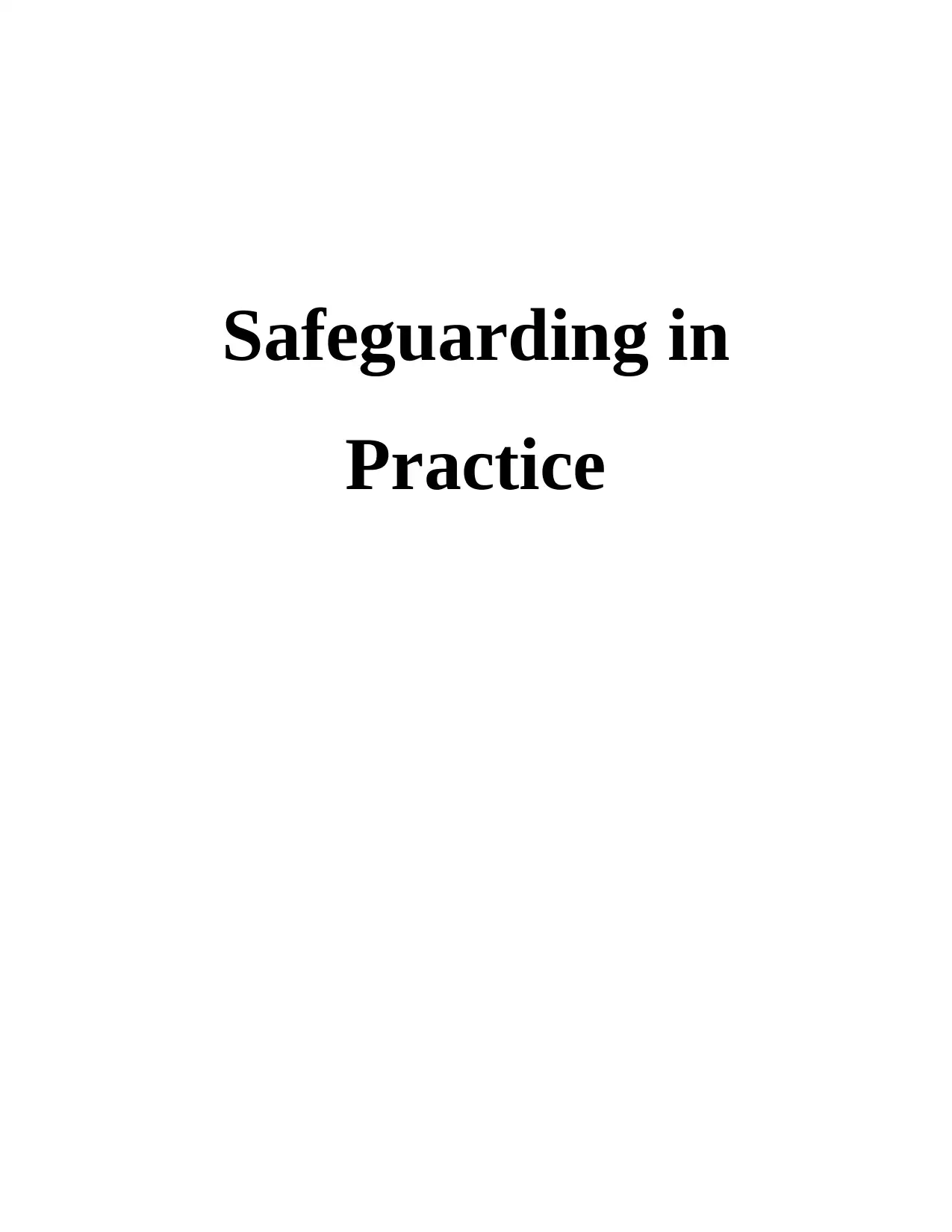
Safeguarding in
Practice
Practice
Paraphrase This Document
Need a fresh take? Get an instant paraphrase of this document with our AI Paraphraser
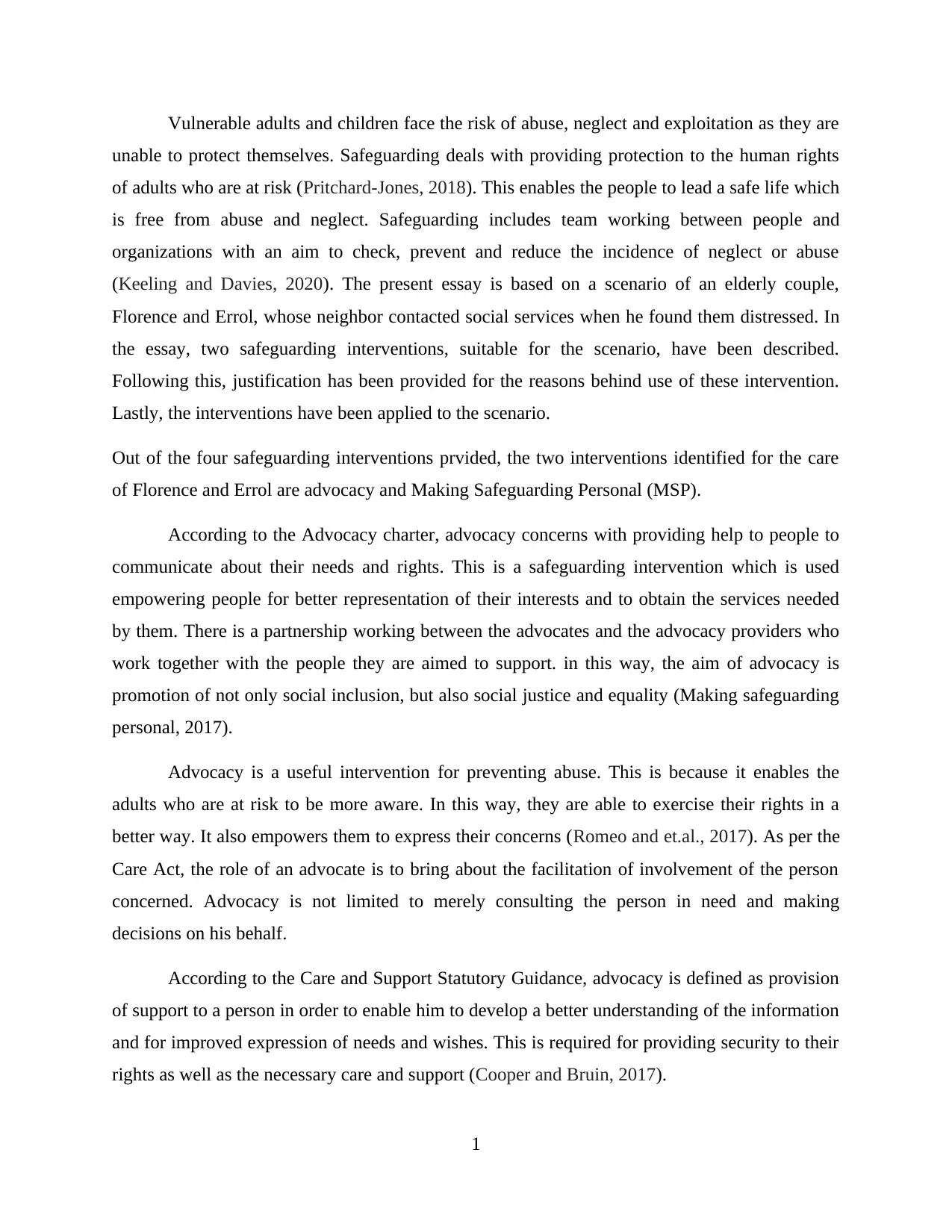
Vulnerable adults and children face the risk of abuse, neglect and exploitation as they are
unable to protect themselves. Safeguarding deals with providing protection to the human rights
of adults who are at risk (Pritchard-Jones, 2018). This enables the people to lead a safe life which
is free from abuse and neglect. Safeguarding includes team working between people and
organizations with an aim to check, prevent and reduce the incidence of neglect or abuse
(Keeling and Davies, 2020). The present essay is based on a scenario of an elderly couple,
Florence and Errol, whose neighbor contacted social services when he found them distressed. In
the essay, two safeguarding interventions, suitable for the scenario, have been described.
Following this, justification has been provided for the reasons behind use of these intervention.
Lastly, the interventions have been applied to the scenario.
Out of the four safeguarding interventions prvided, the two interventions identified for the care
of Florence and Errol are advocacy and Making Safeguarding Personal (MSP).
According to the Advocacy charter, advocacy concerns with providing help to people to
communicate about their needs and rights. This is a safeguarding intervention which is used
empowering people for better representation of their interests and to obtain the services needed
by them. There is a partnership working between the advocates and the advocacy providers who
work together with the people they are aimed to support. in this way, the aim of advocacy is
promotion of not only social inclusion, but also social justice and equality (Making safeguarding
personal, 2017).
Advocacy is a useful intervention for preventing abuse. This is because it enables the
adults who are at risk to be more aware. In this way, they are able to exercise their rights in a
better way. It also empowers them to express their concerns (Romeo and et.al., 2017). As per the
Care Act, the role of an advocate is to bring about the facilitation of involvement of the person
concerned. Advocacy is not limited to merely consulting the person in need and making
decisions on his behalf.
According to the Care and Support Statutory Guidance, advocacy is defined as provision
of support to a person in order to enable him to develop a better understanding of the information
and for improved expression of needs and wishes. This is required for providing security to their
rights as well as the necessary care and support (Cooper and Bruin, 2017).
1
unable to protect themselves. Safeguarding deals with providing protection to the human rights
of adults who are at risk (Pritchard-Jones, 2018). This enables the people to lead a safe life which
is free from abuse and neglect. Safeguarding includes team working between people and
organizations with an aim to check, prevent and reduce the incidence of neglect or abuse
(Keeling and Davies, 2020). The present essay is based on a scenario of an elderly couple,
Florence and Errol, whose neighbor contacted social services when he found them distressed. In
the essay, two safeguarding interventions, suitable for the scenario, have been described.
Following this, justification has been provided for the reasons behind use of these intervention.
Lastly, the interventions have been applied to the scenario.
Out of the four safeguarding interventions prvided, the two interventions identified for the care
of Florence and Errol are advocacy and Making Safeguarding Personal (MSP).
According to the Advocacy charter, advocacy concerns with providing help to people to
communicate about their needs and rights. This is a safeguarding intervention which is used
empowering people for better representation of their interests and to obtain the services needed
by them. There is a partnership working between the advocates and the advocacy providers who
work together with the people they are aimed to support. in this way, the aim of advocacy is
promotion of not only social inclusion, but also social justice and equality (Making safeguarding
personal, 2017).
Advocacy is a useful intervention for preventing abuse. This is because it enables the
adults who are at risk to be more aware. In this way, they are able to exercise their rights in a
better way. It also empowers them to express their concerns (Romeo and et.al., 2017). As per the
Care Act, the role of an advocate is to bring about the facilitation of involvement of the person
concerned. Advocacy is not limited to merely consulting the person in need and making
decisions on his behalf.
According to the Care and Support Statutory Guidance, advocacy is defined as provision
of support to a person in order to enable him to develop a better understanding of the information
and for improved expression of needs and wishes. This is required for providing security to their
rights as well as the necessary care and support (Cooper and Bruin, 2017).
1
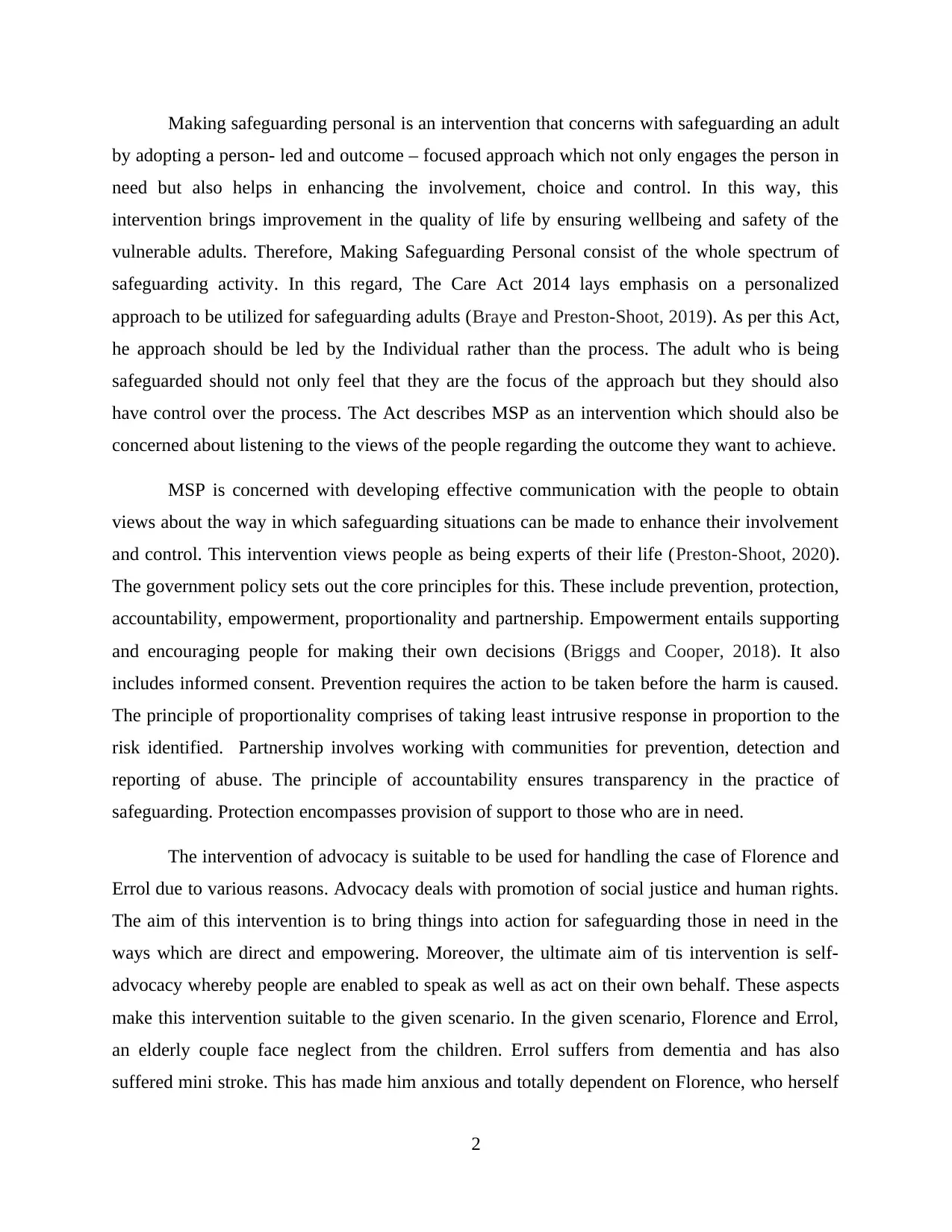
Making safeguarding personal is an intervention that concerns with safeguarding an adult
by adopting a person- led and outcome – focused approach which not only engages the person in
need but also helps in enhancing the involvement, choice and control. In this way, this
intervention brings improvement in the quality of life by ensuring wellbeing and safety of the
vulnerable adults. Therefore, Making Safeguarding Personal consist of the whole spectrum of
safeguarding activity. In this regard, The Care Act 2014 lays emphasis on a personalized
approach to be utilized for safeguarding adults (Braye and Preston-Shoot, 2019). As per this Act,
he approach should be led by the Individual rather than the process. The adult who is being
safeguarded should not only feel that they are the focus of the approach but they should also
have control over the process. The Act describes MSP as an intervention which should also be
concerned about listening to the views of the people regarding the outcome they want to achieve.
MSP is concerned with developing effective communication with the people to obtain
views about the way in which safeguarding situations can be made to enhance their involvement
and control. This intervention views people as being experts of their life (Preston-Shoot, 2020).
The government policy sets out the core principles for this. These include prevention, protection,
accountability, empowerment, proportionality and partnership. Empowerment entails supporting
and encouraging people for making their own decisions (Briggs and Cooper, 2018). It also
includes informed consent. Prevention requires the action to be taken before the harm is caused.
The principle of proportionality comprises of taking least intrusive response in proportion to the
risk identified. Partnership involves working with communities for prevention, detection and
reporting of abuse. The principle of accountability ensures transparency in the practice of
safeguarding. Protection encompasses provision of support to those who are in need.
The intervention of advocacy is suitable to be used for handling the case of Florence and
Errol due to various reasons. Advocacy deals with promotion of social justice and human rights.
The aim of this intervention is to bring things into action for safeguarding those in need in the
ways which are direct and empowering. Moreover, the ultimate aim of tis intervention is self-
advocacy whereby people are enabled to speak as well as act on their own behalf. These aspects
make this intervention suitable to the given scenario. In the given scenario, Florence and Errol,
an elderly couple face neglect from the children. Errol suffers from dementia and has also
suffered mini stroke. This has made him anxious and totally dependent on Florence, who herself
2
by adopting a person- led and outcome – focused approach which not only engages the person in
need but also helps in enhancing the involvement, choice and control. In this way, this
intervention brings improvement in the quality of life by ensuring wellbeing and safety of the
vulnerable adults. Therefore, Making Safeguarding Personal consist of the whole spectrum of
safeguarding activity. In this regard, The Care Act 2014 lays emphasis on a personalized
approach to be utilized for safeguarding adults (Braye and Preston-Shoot, 2019). As per this Act,
he approach should be led by the Individual rather than the process. The adult who is being
safeguarded should not only feel that they are the focus of the approach but they should also
have control over the process. The Act describes MSP as an intervention which should also be
concerned about listening to the views of the people regarding the outcome they want to achieve.
MSP is concerned with developing effective communication with the people to obtain
views about the way in which safeguarding situations can be made to enhance their involvement
and control. This intervention views people as being experts of their life (Preston-Shoot, 2020).
The government policy sets out the core principles for this. These include prevention, protection,
accountability, empowerment, proportionality and partnership. Empowerment entails supporting
and encouraging people for making their own decisions (Briggs and Cooper, 2018). It also
includes informed consent. Prevention requires the action to be taken before the harm is caused.
The principle of proportionality comprises of taking least intrusive response in proportion to the
risk identified. Partnership involves working with communities for prevention, detection and
reporting of abuse. The principle of accountability ensures transparency in the practice of
safeguarding. Protection encompasses provision of support to those who are in need.
The intervention of advocacy is suitable to be used for handling the case of Florence and
Errol due to various reasons. Advocacy deals with promotion of social justice and human rights.
The aim of this intervention is to bring things into action for safeguarding those in need in the
ways which are direct and empowering. Moreover, the ultimate aim of tis intervention is self-
advocacy whereby people are enabled to speak as well as act on their own behalf. These aspects
make this intervention suitable to the given scenario. In the given scenario, Florence and Errol,
an elderly couple face neglect from the children. Errol suffers from dementia and has also
suffered mini stroke. This has made him anxious and totally dependent on Florence, who herself
2
⊘ This is a preview!⊘
Do you want full access?
Subscribe today to unlock all pages.

Trusted by 1+ million students worldwide

feels exhausted. Both of them not only require physical support regarding their care and
maintenance of the house, but also requires moral and emotional support. however, none of the
children lives with them.
There has also been incidence of financial and other abuse from another man called
George who is taking advantage of their vulnerable condition. Advocacy will provide a number
of suitable options that can be taken to support both Florence and Errol. The different types of
advocacy options would include self advocacy, group advocacy, non- instructed advocacy, peer,
citizen and professional advocacy (Advocacy: inclusion, empowerment and human rights, 2021).
Hence, any of these options, that suit Florence and Errol can be adopted to safeguard them.
Therefore, use of advocacy as an intervention is justified.
Another reason behind use of this intervention is that advocacy service of good quality
are person centered. Moreover, these approaches are developed with the utilization of a method
of co- production which aims to maximize the role of the people requiring support (Dixon, Laing
and Valentine, 2020). Florence is often left alone to cater to the maintenance of the house and
other needs. Also, she is the one who has to take care of Errol. Due to lack of support and
awareness, George was able to abuse Florence only because he knew that the couple is
dependent on him and lives alone with no one to take care of. Advocacy is suitable here as it
efficiently caters to the needs of the people who want someone to be their side. This intervention
would enable Florence to stand up for her rights and speak up for her needs and wants. In this
way, she will be able to be aware about the abuse and prevent being a victim by accessing the
required support. moreover, advocacy would further benefit Errol as the advocate would
communicate with the members of the care team so that the necessary support could be provided.
Making Safeguarding Personal as an intervention will be suitable to be used in the given
case. The reason which justifies this is that MSP is an approach that consists of range of
processes which can be used for supporting people to not only improve their life but also resolve
their circumstances. The focus of this intervention is to bring meaningful improvements in the
life of the people by providing ways in which they can protect themselves (Cooper, 2017). This
intervention puts the person at the center of the practice in order to help him or her achieve the
outcomes of life that they desire. The suitability of the selected intervention for the chosen case
is justified as the case demonstrates emotional and psychological abuse of Florence. George,
3
maintenance of the house, but also requires moral and emotional support. however, none of the
children lives with them.
There has also been incidence of financial and other abuse from another man called
George who is taking advantage of their vulnerable condition. Advocacy will provide a number
of suitable options that can be taken to support both Florence and Errol. The different types of
advocacy options would include self advocacy, group advocacy, non- instructed advocacy, peer,
citizen and professional advocacy (Advocacy: inclusion, empowerment and human rights, 2021).
Hence, any of these options, that suit Florence and Errol can be adopted to safeguard them.
Therefore, use of advocacy as an intervention is justified.
Another reason behind use of this intervention is that advocacy service of good quality
are person centered. Moreover, these approaches are developed with the utilization of a method
of co- production which aims to maximize the role of the people requiring support (Dixon, Laing
and Valentine, 2020). Florence is often left alone to cater to the maintenance of the house and
other needs. Also, she is the one who has to take care of Errol. Due to lack of support and
awareness, George was able to abuse Florence only because he knew that the couple is
dependent on him and lives alone with no one to take care of. Advocacy is suitable here as it
efficiently caters to the needs of the people who want someone to be their side. This intervention
would enable Florence to stand up for her rights and speak up for her needs and wants. In this
way, she will be able to be aware about the abuse and prevent being a victim by accessing the
required support. moreover, advocacy would further benefit Errol as the advocate would
communicate with the members of the care team so that the necessary support could be provided.
Making Safeguarding Personal as an intervention will be suitable to be used in the given
case. The reason which justifies this is that MSP is an approach that consists of range of
processes which can be used for supporting people to not only improve their life but also resolve
their circumstances. The focus of this intervention is to bring meaningful improvements in the
life of the people by providing ways in which they can protect themselves (Cooper, 2017). This
intervention puts the person at the center of the practice in order to help him or her achieve the
outcomes of life that they desire. The suitability of the selected intervention for the chosen case
is justified as the case demonstrates emotional and psychological abuse of Florence. George,
3
Paraphrase This Document
Need a fresh take? Get an instant paraphrase of this document with our AI Paraphraser
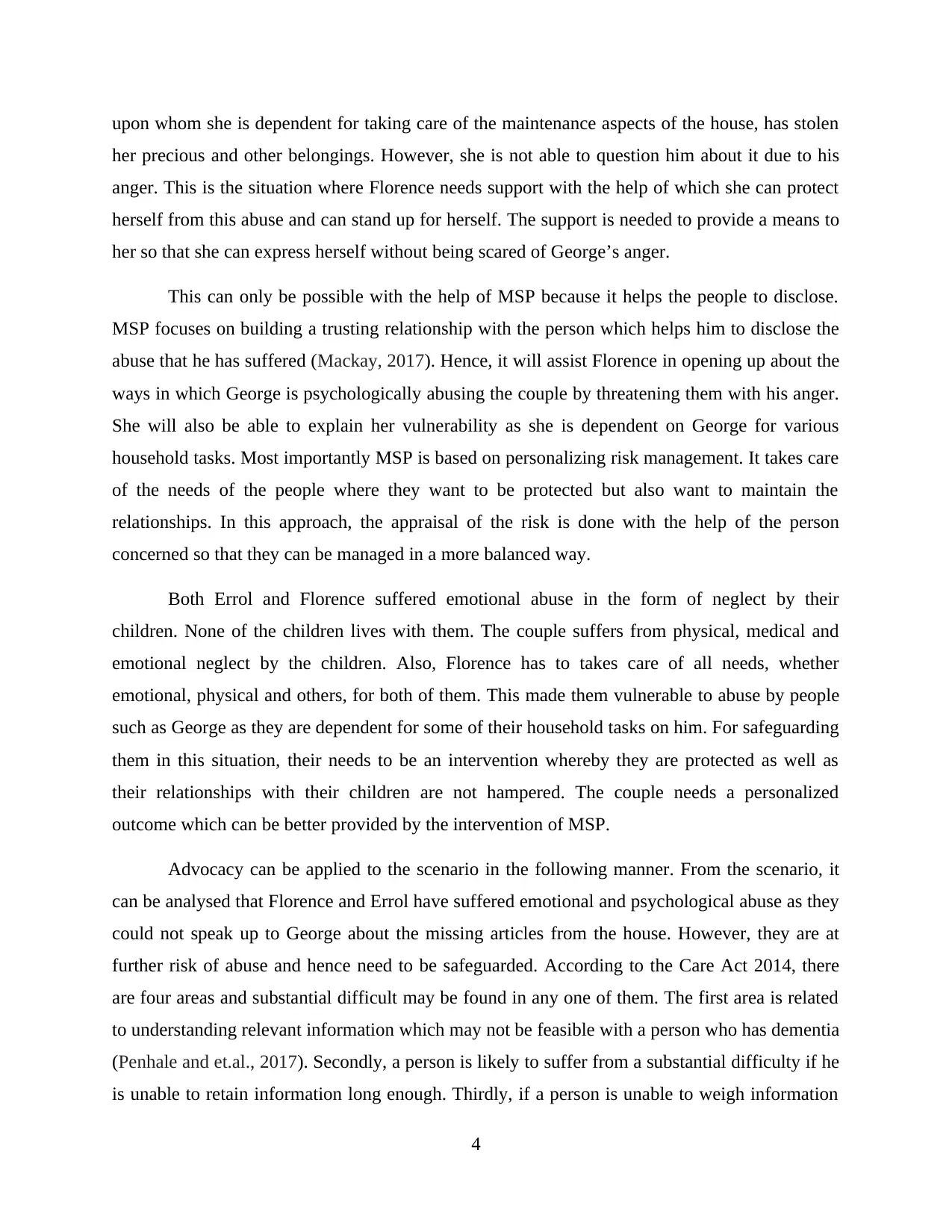
upon whom she is dependent for taking care of the maintenance aspects of the house, has stolen
her precious and other belongings. However, she is not able to question him about it due to his
anger. This is the situation where Florence needs support with the help of which she can protect
herself from this abuse and can stand up for herself. The support is needed to provide a means to
her so that she can express herself without being scared of George’s anger.
This can only be possible with the help of MSP because it helps the people to disclose.
MSP focuses on building a trusting relationship with the person which helps him to disclose the
abuse that he has suffered (Mackay, 2017). Hence, it will assist Florence in opening up about the
ways in which George is psychologically abusing the couple by threatening them with his anger.
She will also be able to explain her vulnerability as she is dependent on George for various
household tasks. Most importantly MSP is based on personalizing risk management. It takes care
of the needs of the people where they want to be protected but also want to maintain the
relationships. In this approach, the appraisal of the risk is done with the help of the person
concerned so that they can be managed in a more balanced way.
Both Errol and Florence suffered emotional abuse in the form of neglect by their
children. None of the children lives with them. The couple suffers from physical, medical and
emotional neglect by the children. Also, Florence has to takes care of all needs, whether
emotional, physical and others, for both of them. This made them vulnerable to abuse by people
such as George as they are dependent for some of their household tasks on him. For safeguarding
them in this situation, their needs to be an intervention whereby they are protected as well as
their relationships with their children are not hampered. The couple needs a personalized
outcome which can be better provided by the intervention of MSP.
Advocacy can be applied to the scenario in the following manner. From the scenario, it
can be analysed that Florence and Errol have suffered emotional and psychological abuse as they
could not speak up to George about the missing articles from the house. However, they are at
further risk of abuse and hence need to be safeguarded. According to the Care Act 2014, there
are four areas and substantial difficult may be found in any one of them. The first area is related
to understanding relevant information which may not be feasible with a person who has dementia
(Penhale and et.al., 2017). Secondly, a person is likely to suffer from a substantial difficulty if he
is unable to retain information long enough. Thirdly, if a person is unable to weigh information
4
her precious and other belongings. However, she is not able to question him about it due to his
anger. This is the situation where Florence needs support with the help of which she can protect
herself from this abuse and can stand up for herself. The support is needed to provide a means to
her so that she can express herself without being scared of George’s anger.
This can only be possible with the help of MSP because it helps the people to disclose.
MSP focuses on building a trusting relationship with the person which helps him to disclose the
abuse that he has suffered (Mackay, 2017). Hence, it will assist Florence in opening up about the
ways in which George is psychologically abusing the couple by threatening them with his anger.
She will also be able to explain her vulnerability as she is dependent on George for various
household tasks. Most importantly MSP is based on personalizing risk management. It takes care
of the needs of the people where they want to be protected but also want to maintain the
relationships. In this approach, the appraisal of the risk is done with the help of the person
concerned so that they can be managed in a more balanced way.
Both Errol and Florence suffered emotional abuse in the form of neglect by their
children. None of the children lives with them. The couple suffers from physical, medical and
emotional neglect by the children. Also, Florence has to takes care of all needs, whether
emotional, physical and others, for both of them. This made them vulnerable to abuse by people
such as George as they are dependent for some of their household tasks on him. For safeguarding
them in this situation, their needs to be an intervention whereby they are protected as well as
their relationships with their children are not hampered. The couple needs a personalized
outcome which can be better provided by the intervention of MSP.
Advocacy can be applied to the scenario in the following manner. From the scenario, it
can be analysed that Florence and Errol have suffered emotional and psychological abuse as they
could not speak up to George about the missing articles from the house. However, they are at
further risk of abuse and hence need to be safeguarded. According to the Care Act 2014, there
are four areas and substantial difficult may be found in any one of them. The first area is related
to understanding relevant information which may not be feasible with a person who has dementia
(Penhale and et.al., 2017). Secondly, a person is likely to suffer from a substantial difficulty if he
is unable to retain information long enough. Thirdly, if a person is unable to weigh information
4
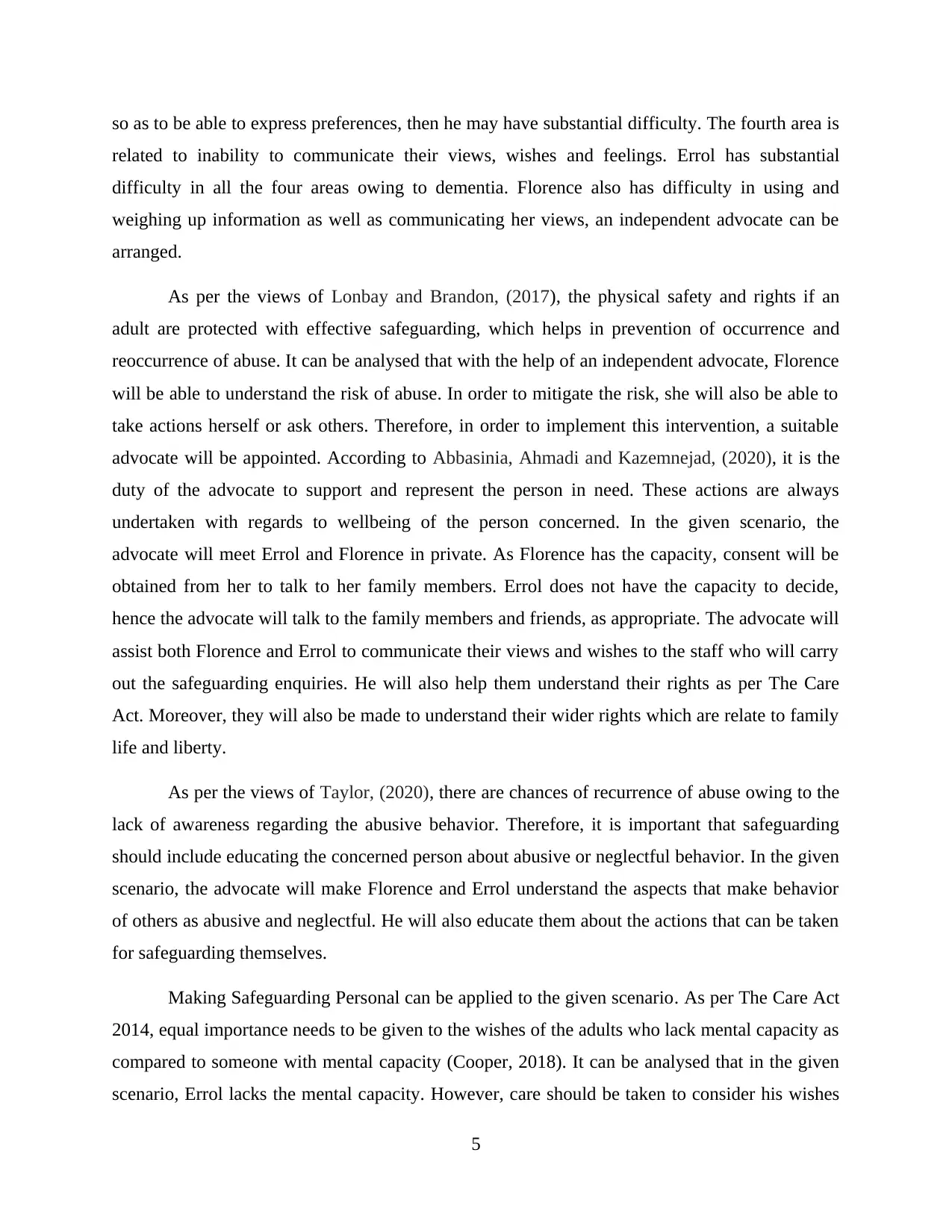
so as to be able to express preferences, then he may have substantial difficulty. The fourth area is
related to inability to communicate their views, wishes and feelings. Errol has substantial
difficulty in all the four areas owing to dementia. Florence also has difficulty in using and
weighing up information as well as communicating her views, an independent advocate can be
arranged.
As per the views of Lonbay and Brandon, (2017), the physical safety and rights if an
adult are protected with effective safeguarding, which helps in prevention of occurrence and
reoccurrence of abuse. It can be analysed that with the help of an independent advocate, Florence
will be able to understand the risk of abuse. In order to mitigate the risk, she will also be able to
take actions herself or ask others. Therefore, in order to implement this intervention, a suitable
advocate will be appointed. According to Abbasinia, Ahmadi and Kazemnejad, (2020), it is the
duty of the advocate to support and represent the person in need. These actions are always
undertaken with regards to wellbeing of the person concerned. In the given scenario, the
advocate will meet Errol and Florence in private. As Florence has the capacity, consent will be
obtained from her to talk to her family members. Errol does not have the capacity to decide,
hence the advocate will talk to the family members and friends, as appropriate. The advocate will
assist both Florence and Errol to communicate their views and wishes to the staff who will carry
out the safeguarding enquiries. He will also help them understand their rights as per The Care
Act. Moreover, they will also be made to understand their wider rights which are relate to family
life and liberty.
As per the views of Taylor, (2020), there are chances of recurrence of abuse owing to the
lack of awareness regarding the abusive behavior. Therefore, it is important that safeguarding
should include educating the concerned person about abusive or neglectful behavior. In the given
scenario, the advocate will make Florence and Errol understand the aspects that make behavior
of others as abusive and neglectful. He will also educate them about the actions that can be taken
for safeguarding themselves.
Making Safeguarding Personal can be applied to the given scenario. As per The Care Act
2014, equal importance needs to be given to the wishes of the adults who lack mental capacity as
compared to someone with mental capacity (Cooper, 2018). It can be analysed that in the given
scenario, Errol lacks the mental capacity. However, care should be taken to consider his wishes
5
related to inability to communicate their views, wishes and feelings. Errol has substantial
difficulty in all the four areas owing to dementia. Florence also has difficulty in using and
weighing up information as well as communicating her views, an independent advocate can be
arranged.
As per the views of Lonbay and Brandon, (2017), the physical safety and rights if an
adult are protected with effective safeguarding, which helps in prevention of occurrence and
reoccurrence of abuse. It can be analysed that with the help of an independent advocate, Florence
will be able to understand the risk of abuse. In order to mitigate the risk, she will also be able to
take actions herself or ask others. Therefore, in order to implement this intervention, a suitable
advocate will be appointed. According to Abbasinia, Ahmadi and Kazemnejad, (2020), it is the
duty of the advocate to support and represent the person in need. These actions are always
undertaken with regards to wellbeing of the person concerned. In the given scenario, the
advocate will meet Errol and Florence in private. As Florence has the capacity, consent will be
obtained from her to talk to her family members. Errol does not have the capacity to decide,
hence the advocate will talk to the family members and friends, as appropriate. The advocate will
assist both Florence and Errol to communicate their views and wishes to the staff who will carry
out the safeguarding enquiries. He will also help them understand their rights as per The Care
Act. Moreover, they will also be made to understand their wider rights which are relate to family
life and liberty.
As per the views of Taylor, (2020), there are chances of recurrence of abuse owing to the
lack of awareness regarding the abusive behavior. Therefore, it is important that safeguarding
should include educating the concerned person about abusive or neglectful behavior. In the given
scenario, the advocate will make Florence and Errol understand the aspects that make behavior
of others as abusive and neglectful. He will also educate them about the actions that can be taken
for safeguarding themselves.
Making Safeguarding Personal can be applied to the given scenario. As per The Care Act
2014, equal importance needs to be given to the wishes of the adults who lack mental capacity as
compared to someone with mental capacity (Cooper, 2018). It can be analysed that in the given
scenario, Errol lacks the mental capacity. However, care should be taken to consider his wishes
5
⊘ This is a preview!⊘
Do you want full access?
Subscribe today to unlock all pages.

Trusted by 1+ million students worldwide
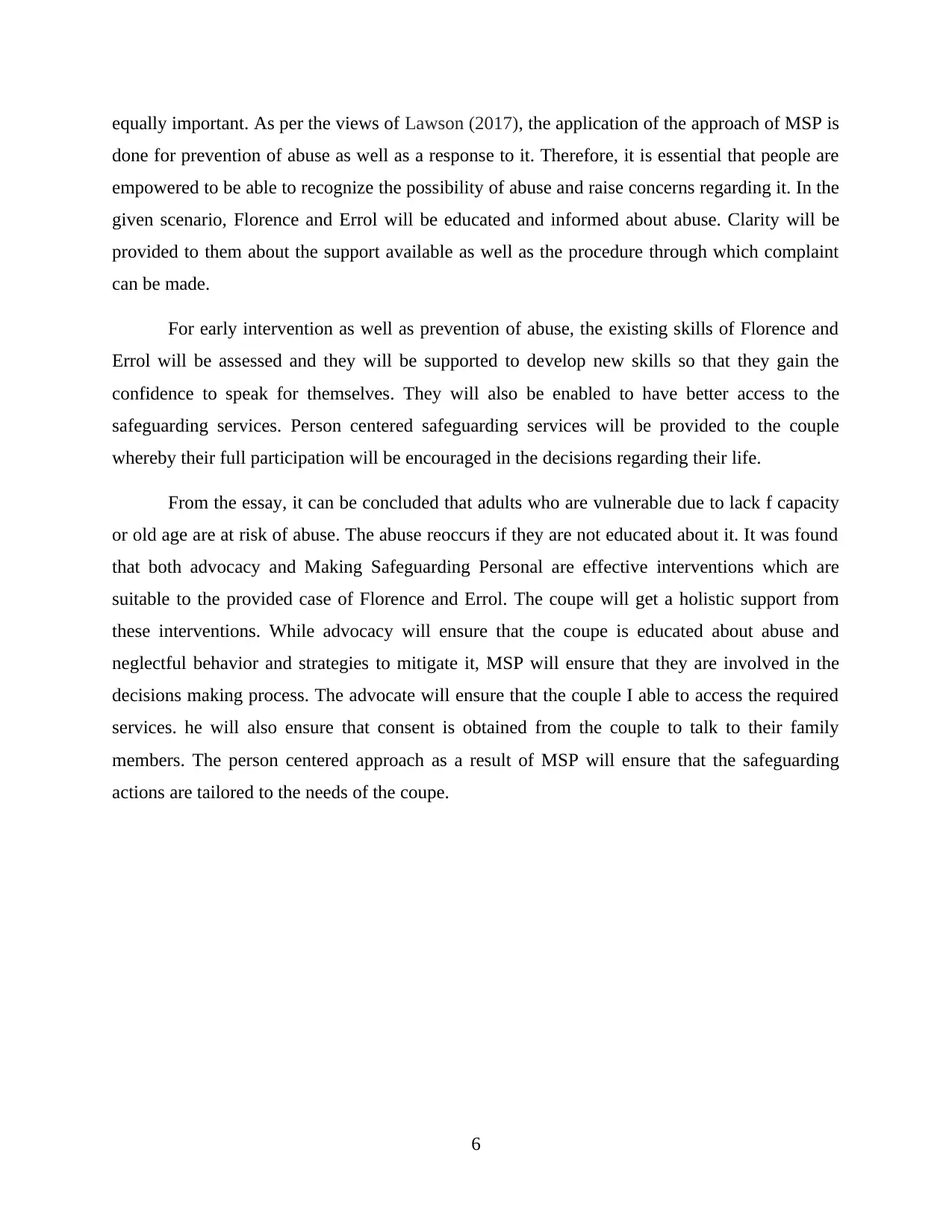
equally important. As per the views of Lawson (2017), the application of the approach of MSP is
done for prevention of abuse as well as a response to it. Therefore, it is essential that people are
empowered to be able to recognize the possibility of abuse and raise concerns regarding it. In the
given scenario, Florence and Errol will be educated and informed about abuse. Clarity will be
provided to them about the support available as well as the procedure through which complaint
can be made.
For early intervention as well as prevention of abuse, the existing skills of Florence and
Errol will be assessed and they will be supported to develop new skills so that they gain the
confidence to speak for themselves. They will also be enabled to have better access to the
safeguarding services. Person centered safeguarding services will be provided to the couple
whereby their full participation will be encouraged in the decisions regarding their life.
From the essay, it can be concluded that adults who are vulnerable due to lack f capacity
or old age are at risk of abuse. The abuse reoccurs if they are not educated about it. It was found
that both advocacy and Making Safeguarding Personal are effective interventions which are
suitable to the provided case of Florence and Errol. The coupe will get a holistic support from
these interventions. While advocacy will ensure that the coupe is educated about abuse and
neglectful behavior and strategies to mitigate it, MSP will ensure that they are involved in the
decisions making process. The advocate will ensure that the couple I able to access the required
services. he will also ensure that consent is obtained from the couple to talk to their family
members. The person centered approach as a result of MSP will ensure that the safeguarding
actions are tailored to the needs of the coupe.
6
done for prevention of abuse as well as a response to it. Therefore, it is essential that people are
empowered to be able to recognize the possibility of abuse and raise concerns regarding it. In the
given scenario, Florence and Errol will be educated and informed about abuse. Clarity will be
provided to them about the support available as well as the procedure through which complaint
can be made.
For early intervention as well as prevention of abuse, the existing skills of Florence and
Errol will be assessed and they will be supported to develop new skills so that they gain the
confidence to speak for themselves. They will also be enabled to have better access to the
safeguarding services. Person centered safeguarding services will be provided to the couple
whereby their full participation will be encouraged in the decisions regarding their life.
From the essay, it can be concluded that adults who are vulnerable due to lack f capacity
or old age are at risk of abuse. The abuse reoccurs if they are not educated about it. It was found
that both advocacy and Making Safeguarding Personal are effective interventions which are
suitable to the provided case of Florence and Errol. The coupe will get a holistic support from
these interventions. While advocacy will ensure that the coupe is educated about abuse and
neglectful behavior and strategies to mitigate it, MSP will ensure that they are involved in the
decisions making process. The advocate will ensure that the couple I able to access the required
services. he will also ensure that consent is obtained from the couple to talk to their family
members. The person centered approach as a result of MSP will ensure that the safeguarding
actions are tailored to the needs of the coupe.
6
Paraphrase This Document
Need a fresh take? Get an instant paraphrase of this document with our AI Paraphraser
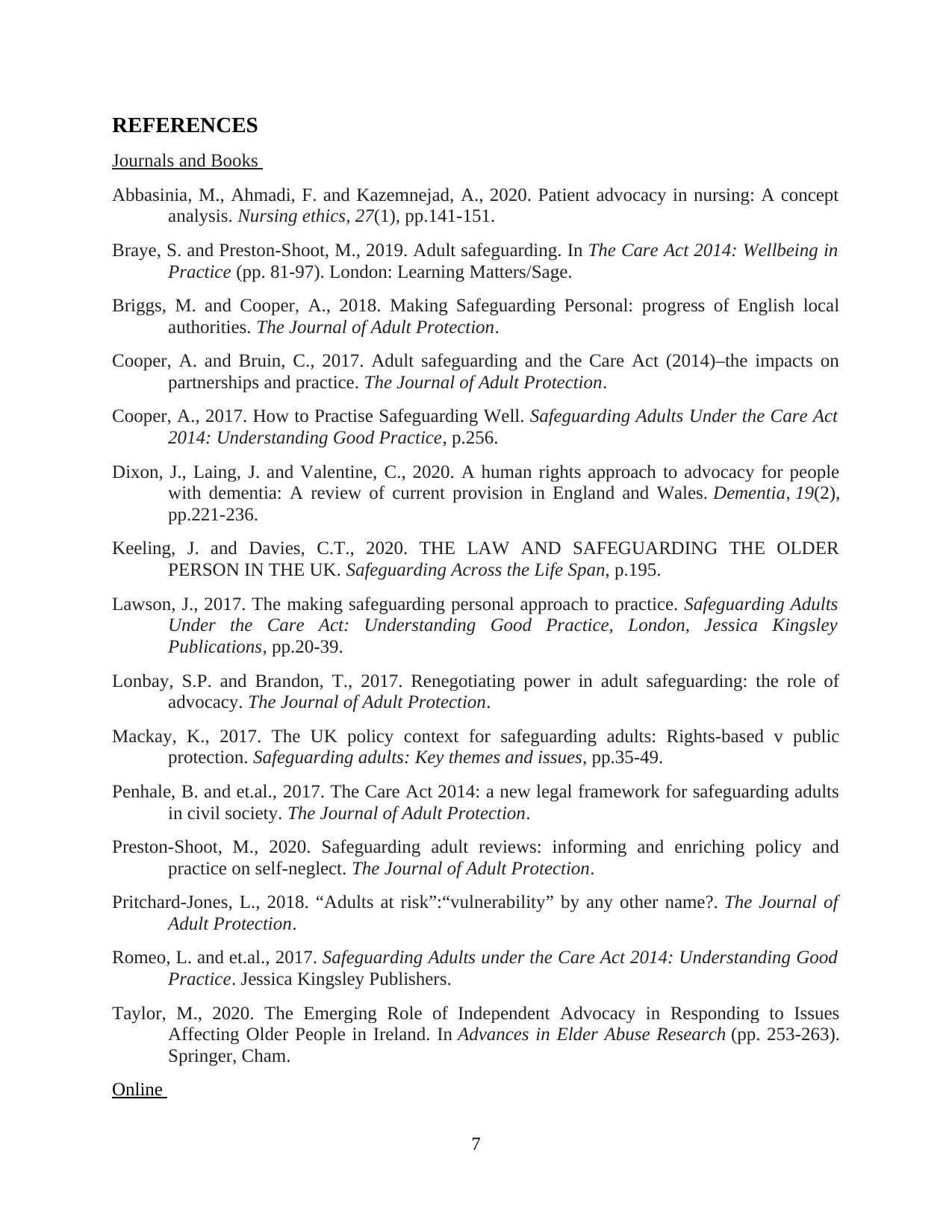
REFERENCES
Journals and Books
Abbasinia, M., Ahmadi, F. and Kazemnejad, A., 2020. Patient advocacy in nursing: A concept
analysis. Nursing ethics, 27(1), pp.141-151.
Braye, S. and Preston-Shoot, M., 2019. Adult safeguarding. In The Care Act 2014: Wellbeing in
Practice (pp. 81-97). London: Learning Matters/Sage.
Briggs, M. and Cooper, A., 2018. Making Safeguarding Personal: progress of English local
authorities. The Journal of Adult Protection.
Cooper, A. and Bruin, C., 2017. Adult safeguarding and the Care Act (2014)–the impacts on
partnerships and practice. The Journal of Adult Protection.
Cooper, A., 2017. How to Practise Safeguarding Well. Safeguarding Adults Under the Care Act
2014: Understanding Good Practice, p.256.
Dixon, J., Laing, J. and Valentine, C., 2020. A human rights approach to advocacy for people
with dementia: A review of current provision in England and Wales. Dementia, 19(2),
pp.221-236.
Keeling, J. and Davies, C.T., 2020. THE LAW AND SAFEGUARDING THE OLDER
PERSON IN THE UK. Safeguarding Across the Life Span, p.195.
Lawson, J., 2017. The making safeguarding personal approach to practice. Safeguarding Adults
Under the Care Act: Understanding Good Practice, London, Jessica Kingsley
Publications, pp.20-39.
Lonbay, S.P. and Brandon, T., 2017. Renegotiating power in adult safeguarding: the role of
advocacy. The Journal of Adult Protection.
Mackay, K., 2017. The UK policy context for safeguarding adults: Rights-based v public
protection. Safeguarding adults: Key themes and issues, pp.35-49.
Penhale, B. and et.al., 2017. The Care Act 2014: a new legal framework for safeguarding adults
in civil society. The Journal of Adult Protection.
Preston-Shoot, M., 2020. Safeguarding adult reviews: informing and enriching policy and
practice on self-neglect. The Journal of Adult Protection.
Pritchard-Jones, L., 2018. “Adults at risk”:“vulnerability” by any other name?. The Journal of
Adult Protection.
Romeo, L. and et.al., 2017. Safeguarding Adults under the Care Act 2014: Understanding Good
Practice. Jessica Kingsley Publishers.
Taylor, M., 2020. The Emerging Role of Independent Advocacy in Responding to Issues
Affecting Older People in Ireland. In Advances in Elder Abuse Research (pp. 253-263).
Springer, Cham.
Online
7
Journals and Books
Abbasinia, M., Ahmadi, F. and Kazemnejad, A., 2020. Patient advocacy in nursing: A concept
analysis. Nursing ethics, 27(1), pp.141-151.
Braye, S. and Preston-Shoot, M., 2019. Adult safeguarding. In The Care Act 2014: Wellbeing in
Practice (pp. 81-97). London: Learning Matters/Sage.
Briggs, M. and Cooper, A., 2018. Making Safeguarding Personal: progress of English local
authorities. The Journal of Adult Protection.
Cooper, A. and Bruin, C., 2017. Adult safeguarding and the Care Act (2014)–the impacts on
partnerships and practice. The Journal of Adult Protection.
Cooper, A., 2017. How to Practise Safeguarding Well. Safeguarding Adults Under the Care Act
2014: Understanding Good Practice, p.256.
Dixon, J., Laing, J. and Valentine, C., 2020. A human rights approach to advocacy for people
with dementia: A review of current provision in England and Wales. Dementia, 19(2),
pp.221-236.
Keeling, J. and Davies, C.T., 2020. THE LAW AND SAFEGUARDING THE OLDER
PERSON IN THE UK. Safeguarding Across the Life Span, p.195.
Lawson, J., 2017. The making safeguarding personal approach to practice. Safeguarding Adults
Under the Care Act: Understanding Good Practice, London, Jessica Kingsley
Publications, pp.20-39.
Lonbay, S.P. and Brandon, T., 2017. Renegotiating power in adult safeguarding: the role of
advocacy. The Journal of Adult Protection.
Mackay, K., 2017. The UK policy context for safeguarding adults: Rights-based v public
protection. Safeguarding adults: Key themes and issues, pp.35-49.
Penhale, B. and et.al., 2017. The Care Act 2014: a new legal framework for safeguarding adults
in civil society. The Journal of Adult Protection.
Preston-Shoot, M., 2020. Safeguarding adult reviews: informing and enriching policy and
practice on self-neglect. The Journal of Adult Protection.
Pritchard-Jones, L., 2018. “Adults at risk”:“vulnerability” by any other name?. The Journal of
Adult Protection.
Romeo, L. and et.al., 2017. Safeguarding Adults under the Care Act 2014: Understanding Good
Practice. Jessica Kingsley Publishers.
Taylor, M., 2020. The Emerging Role of Independent Advocacy in Responding to Issues
Affecting Older People in Ireland. In Advances in Elder Abuse Research (pp. 253-263).
Springer, Cham.
Online
7
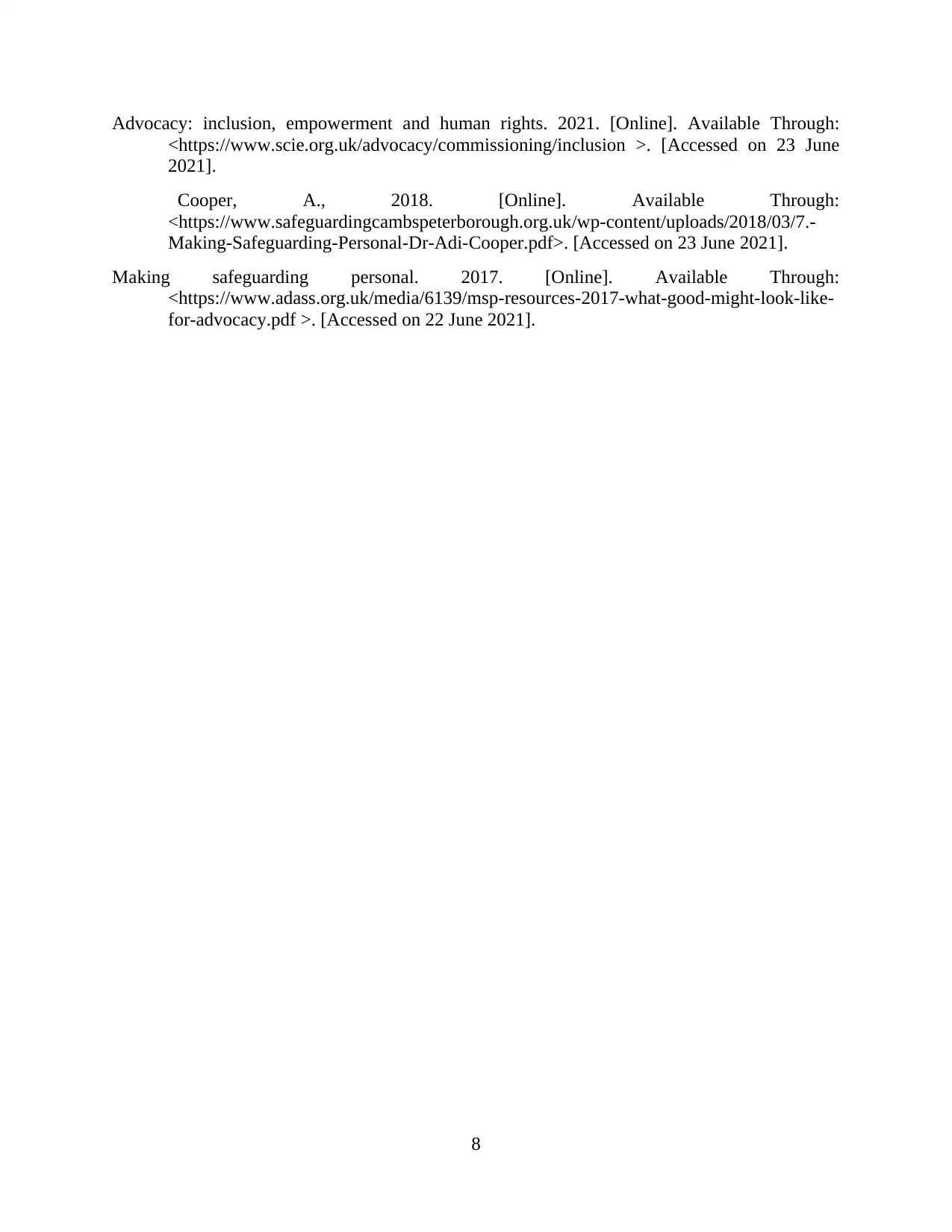
Advocacy: inclusion, empowerment and human rights. 2021. [Online]. Available Through:
<https://www.scie.org.uk/advocacy/commissioning/inclusion >. [Accessed on 23 June
2021].
Cooper, A., 2018. [Online]. Available Through:
<https://www.safeguardingcambspeterborough.org.uk/wp-content/uploads/2018/03/7.-
Making-Safeguarding-Personal-Dr-Adi-Cooper.pdf>. [Accessed on 23 June 2021].
Making safeguarding personal. 2017. [Online]. Available Through:
<https://www.adass.org.uk/media/6139/msp-resources-2017-what-good-might-look-like-
for-advocacy.pdf >. [Accessed on 22 June 2021].
8
<https://www.scie.org.uk/advocacy/commissioning/inclusion >. [Accessed on 23 June
2021].
Cooper, A., 2018. [Online]. Available Through:
<https://www.safeguardingcambspeterborough.org.uk/wp-content/uploads/2018/03/7.-
Making-Safeguarding-Personal-Dr-Adi-Cooper.pdf>. [Accessed on 23 June 2021].
Making safeguarding personal. 2017. [Online]. Available Through:
<https://www.adass.org.uk/media/6139/msp-resources-2017-what-good-might-look-like-
for-advocacy.pdf >. [Accessed on 22 June 2021].
8
⊘ This is a preview!⊘
Do you want full access?
Subscribe today to unlock all pages.

Trusted by 1+ million students worldwide
1 out of 9
Related Documents
Your All-in-One AI-Powered Toolkit for Academic Success.
+13062052269
info@desklib.com
Available 24*7 on WhatsApp / Email
![[object Object]](/_next/static/media/star-bottom.7253800d.svg)
Unlock your academic potential
Copyright © 2020–2025 A2Z Services. All Rights Reserved. Developed and managed by ZUCOL.





